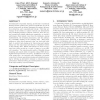138 search results - page 24 / 28 » Divide-and-Conquer Strategies for Process Mining |
KDD
2009
ACM
14 years 8 months ago
2009
ACM
Many scalable data mining tasks rely on active learning to provide the most useful accurately labeled instances. However, what if there are multiple labeling sources (`oracles...
KDD
2005
ACM
14 years 8 months ago
2005
ACM
Discriminative sequential learning models like Conditional Random Fields (CRFs) have achieved significant success in several areas such as natural language processing, information...
KDD
2004
ACM
14 years 8 months ago
2004
ACM
Essentially all data mining algorithms assume that the datagenerating process is independent of the data miner's activities. However, in many domains, including spam detectio...
PKDD
2007
Springer
14 years 1 months ago
2007
Springer
Collaborative tagging systems allow users to assign keywords—so called “tags”—to resources. Tags are used for navigation, finding resources and serendipitous browsing and ...
KDD
2008
ACM
14 years 8 months ago
2008
ACM
We present a detailed study of network evolution by analyzing four large online social networks with full temporal information about node and edge arrivals. For the first time at ...

